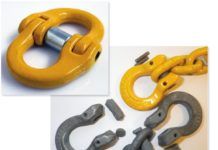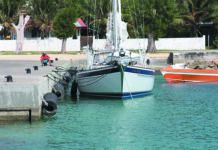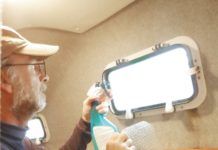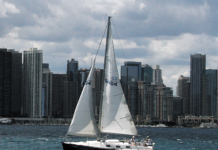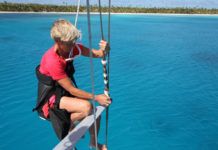
As we explore material legacies and evolution with a regenerative lens for our Wharram Narai Mk IV build, the focus now shifts to sheathing techniques and materials that provide strength, water resistance and longevity. Historically, boatbuilders used natural materials like tar, animal hides and plant fibers to protect and reinforce wooden vessels. Today, there’s an urgency for boat builders to explore natural fiber composites as alternatives to plastic-based sheathing materials like nylon and glass-reinforced plastic (GRP), which negatively impact marine environments.
I’ve narrowed down my research to investigate the different techniques for applying fiber-reinforced composites (FRC) to boat hulls, whilst focusing on flax, hemp and basalt fibers, which have emerged as promising natural alternatives to traditional synthetic materials and potential options for a ply/epoxy Wharram catamaran. These promising materials offer significant ecological benefits, but the challenge is ensuring they meet the technical demands of marine environments, especially in terms of durability, accessibility and cost.
A Look Back: Traditional Knowledge and Natural Materials
Before diving into modern sheathing techniques, it’s important to recognize that regenerative boatbuilding doesn’t start with contemporary innovations. It starts by looking back. Traditional Ecological Knowledge (TEK), practiced by Indigenous seafaring cultures for millennia, offers a blueprint for sustainable boatbuilding. Polynesian vakas (double-hulled canoes), Viking longships, and indigenous boats of the Pacific Northwest are prime examples of regenerative design, using local natural materials in ways that allowed ecosystems to thrive.
In Polynesia—of particular interest to Wharram builders—boatbuilders lashed hulls together with coconut fiber and used wooden pegs and ropes instead of synthetic fasteners. These materials allowed for flexible, long-lasting vessels that required no industrialized processes or materials. TEK demonstrates how natural fibers, thoughtfully sourced and applied, can create durable, adaptable boats without the ecological footprint associated with modern materials like GRP.
This respect for local, sustainable resources and ecological balance is central to the Wharram philosophy, and it is what guides us as we consider sheathing our Narai Mk IV.
Sheathing Techniques: Applying Natural Fiber Composites
The goal of sheathing is to protect the wooden hull from water, UV damage and mechanical wear. Traditional glass-reinforced plastic (GRP) has dominated sheathing for decades, but the environmental consequences of its production and disposal are significant. Instead, we want to explore the possibility of using natural fibers combined with bio-resins. But can these materials be applied in accessible, affordable ways to ensure that much-needed long-lasting protection?
There are several methods for applying fiber-reinforced composites to wooden boat hulls, each with its own advantages and limitations. Let’s explore the key techniques and how natural fibers can be integrated into them.
Hand Lay-Up Method

The hand lay-up method is one of the most widely used sheathing techniques in boatbuilding, particularly favored by DIY builders for its simplicity and low entry cost. This process involves layering sheets of fiber cloth over the wooden surface of the hull. Resin is then applied manually with brushes or rollers, saturating the fibers and creating a laminate layer that adheres to the wood. The method relies heavily on manual effort, requiring builders to ensure even application and saturation of resin to avoid weak spots.
Pros:
Low Cost. The hand lay-up method is budget-friendly, requiring only basic tools like brushes, rollers and mixing containers. This makes it an ideal option for builders who are looking to save on costs, as there is no need for specialized equipment such as vacuum pumps or infusion systems.
Simplicity. The technique is straightforward and doesn’t require extensive training or experience. This accessibility makes it appealing to self-builders who may be new to sheathing techniques. The process can be learned quickly, allowing builders to begin work without extensive setup.
DIY-Friendly. Since the method does not require a controlled environment, it can be carried out in a variety of spaces, from small workshops to outdoor setups. This makes it an adaptable choice for DIY enthusiasts working on their own projects, and provides accessibility for ongoing maintenance be it required at sea or in boatyards around the world.
Cons:
Labor-Intensive. Applying resin by hand is a time-consuming process that requires close attention to detail. Achieving uniform saturation across large surfaces can be challenging, leading to inconsistencies in the laminate’s strength if not done meticulously. The repetitive nature of the work also demands stamina, making it potentially tiring for solo builders.
Heavy Resin Use. Due to the manual nature of the application, the hand lay-up method tends to consume more resin compared to other methods. Excessive resin can increase costs, add unnecessary weight, and result in a less efficient use of materials, impacting both the budget and environmental footprint.
Lower Strength-to-Weight Ratio. The effectiveness of the bond between the fiber and resin is highly dependent on the builder’s skill. Inconsistent application can lead to air pockets or uneven resin distribution, reducing the overall structural integrity of the laminate. The quality of the final product may vary, especially if the builder is inexperienced.
Bottom Line
When using natural fibers like flax or hemp, additional protective coatings are essential to address the natural fibers’ vulnerability to moisture and UV exposure. Applying bio-resin coatings or UV-resistant varnishes can significantly enhance durability, but care must be taken to select resins compatible with natural fibers. For example, flax fiber combined with a bio-resin like pine oil-based epoxy provides excellent water resistance. However, without proper UV protection, natural fibers can degrade over time, necessitating regular maintenance or re-coating.
Vacuum-Assisted Resin Transfer Molding (VARTM)
Vacuum-Assisted Resin Transfer Molding (VARTM) is a more advanced and precise sheathing method widely used in commercial boatbuilding. In VARTM, fiber fabric is laid over the hull and covered with a vacuum bag, creating a sealed environment. Resin is then injected into the fabric under pressure, allowing the vacuum to pull the resin evenly throughout the fibers. This method achieves consistent, high-quality laminates with optimal strength and minimal waste, though it requires a higher initial investment in equipment.
Pros:
High Strength-to-Weight Ratio. The vacuum ensures that resin penetrates deeply and uniformly into the fiber fabric, eliminating air pockets and producing a compact, high-density laminate. This results in a strong yet lightweight composite layer, which is essential for maintaining the vessel’s structural integrity and performance in marine conditions.
Less Resin Waste. Unlike hand lay-up, VARTM allows for precise control over resin application, minimizing excess resin and reducing material costs. This controlled resin use not only cuts down on waste but also produces a lighter laminate, which benefits fuel efficiency and maneuverability.
Consistent Results. VARTM provides a highly uniform application, which leads to greater durability and quality. By ensuring that the resin fully saturates the fabric under controlled conditions, VARTM yields a high-performance laminate less susceptible to variations in strength or thickness, making it suitable for critical marine applications.
Cons:
Expensive Equipment. VARTM requires specialized tools, including vacuum pumps, bags and fittings, which can be costly. For DIY builders or those working on a tight budget, the investment in this equipment may be prohibitive, especially for one-time projects or small-scale builds.
Complexity. The VARTM setup is more involved, requiring technical knowledge and experience to execute correctly. Builders must carefully monitor the vacuum pressure and resin flow to avoid problems like dry spots or resin pooling, which can compromise the laminate’s strength.
Plastic Waste. Standard VARTM processes use single-use vacuum bags and other consumable materials, which contribute to plastic waste. While reusable vacuum bags are becoming available, they are still not widely adopted, making this method less environmentally friendly for builders prioritizing sustainability.
Bottom Line
VARTM is particularly effective for high-performance laminates using flax or basalt fibers, producing strong, lightweight sheathing layers with minimal waste. However, the complexity and waste generated by vacuum bagging limit its appeal for DIY and regenerative builds, as these factors can contradict eco-friendly goals. Despite its potential, VARTM remains more practical for commercial applications or builders with access to advanced resources.
Resin Infusion
Resin infusion is similar to VARTM but typically involves lower pressure and fewer requirements for equipment, making it more accessible for DIY builders seeking a compromise between hand lay-up and VARTM. In resin infusion, resin is drawn into the fiber fabric through atmospheric pressure, allowing the fabric to be thoroughly saturated without the need for a vacuum bag. This technique balances efficiency and cost, offering good resin control and reduced waste compared to hand lay-up.
Pros:
Lower Cost than VARTM. Resin infusion requires fewer specialized components, such as vacuum equipment, making it a more affordable option. The method still benefits from controlled resin distribution, which helps minimize waste while maintaining strength.
Improved Resin Control. Resin infusion allows builders to control the amount of resin more precisely, resulting in efficient use and a more consistent laminate. This approach helps to achieve a better strength-to-weight ratio than hand lay-up, as excess resin is less likely to pool or create weak spots.
DIY-Adaptable. While resin infusion is more involved than hand lay-up, it’s still feasible for experienced DIY builders. With some practice and preparation, builders can achieve a high-quality laminate that performs well in marine environments without the full technical setup of VARTM.
Cons:
Moderate Difficulty. Resin infusion requires a certain level of skill and experience, as builders must control the resin flow and ensure it distributes evenly. Errors in setup or resin flow can lead to dry spots or weak areas in the laminate, which may compromise its durability.
Dependent on Resin Flow. Unlike VARTM, where vacuum pressure ensures uniform distribution, resin infusion relies on gravity and atmospheric pressure. If the resin doesn’t flow smoothly or adequately saturate the fabric, the resulting laminate may have inconsistencies that affect its performance.
Bottom Line
For DIY boatbuilders working with natural fibers like flax or hemp, resin infusion is an efficient middle ground between the simplicity of hand lay-up and the precision of VARTM. This method allows for strong, lightweight sheathing with less resin waste, making it suitable for builders focused on eco-friendly practices. However, resin infusion requires careful planning and an understanding of resin flow dynamics to ensure high-quality results.
Sheathing Materials: Cloth Options for the Narai Mk IV
The durability and effectiveness of the sheathing layer for the Narai Mk IV catamaran largely depend on selecting the right combination of fiber and resin. Traditional fiberglass cloth with epoxy has long been the combination used for this purpose, but as these materials pose significant environmental and health risks due to the energy-intensive production processes and the difficulty of disposing of non-biodegradable materials, we need to be at least addressing these issues. As such, we have been exploring the current state of natural fiber alternatives—flax, hemp and basalt—that could be promising as sustainable and effective alternatives, especially when used with high quality bio-resins.
Flax

Flax fiber is increasingly popular in composite applications due to its good tensile strength and significantly lower environmental impact compared to synthetic fibers like fiberglass. The cultivation of flax requires less water, fewer pesticides and minimal fertilizer compared to other fiber crops, resulting in a lower carbon footprint. Additionally, flax fibers on their own are biodegradable, which makes them an attractive option for projects focused on environmental sustainability.
Pros: Flax has a low carbon footprint and requires fewer inputs to cultivate, making it an environmentally friendly option. The fiber exhibits good tensile strength for its weight, comparable to that of glass fibers in some respects. Flax is also fully biodegradable under natural conditions, reducing the environmental impact at the end of its lifecycle.
Cons: Flax fibers are hydrophilic, meaning they readily absorb moisture, which can compromise the composite’s integrity over time. Additionally, flax is susceptible to UV degradation, which necessitates a bio-resin coating or UV-protective varnish to prolong its lifespan in marine environments. To ensure durability, flax composites must be paired with bio-resins that provide waterproofing while enhancing UV resistance. Without proper sealing, flax fibers may degrade more quickly, especially in a wet marine setting.
Hemp

Hemp offers similar benefits to flax, with the added advantage of even faster growth rates and higher tensile strength. Hemp’s rapid growth and high biomass yield per acre make it highly sustainable, as it requires minimal agricultural inputs and naturally resists pests and diseases. The fiber’s inherent mold and mildew resistance further increases its viability in damp or humid environments like those encountered in marine applications.
Pros: Hemp’s natural strength and resistance to mold make it an ideal choice for reinforcing boat hulls. Its cultivation is highly sustainable due to rapid growth, requiring minimal pesticides and fertilizers. Additionally, hemp’s structure provides good tensile strength and stiffness when used in composite form, helping maintain the structural integrity of wooden hulls.
Cons: Similar to flax, hemp fibers absorb moisture, which may lead to weakening and potential degradation over time. Hemp-based composites require a high-performance resin, such as a bio-epoxy, to ensure that moisture does not penetrate the material. Like flax, hemp also needs UV protection to prevent degradation when exposed to sunlight. These requirements increase the complexity and cost of using hemp in marine composites, as extra layers of protection must be applied to safeguard the hull. Much more research and development is required before hemp could become a competitive sustainable alternative.
Basalt
Basalt fibers, derived from volcanic rock, provide a mineral-based alternative to synthetic fibers like fiberglass. Known for their mechanical strength, basalt fibers exhibit high tensile strength, UV resistance and durability against extreme temperatures, making them particularly suitable for marine applications. Basalt’s unique mineral composition also enhances its bonding with bio-resins, resulting in robust composites. According to a study by Kandare et al. (2016), basalt fiber-reinforced bio-resin composites demonstrate tensile strength that is 6 percent to 17 percent higher than traditional epoxy laminates, highlighting basalt’s potential as a viable material for eco-conscious marine sheathing applications.
Pros: Basalt fibers offer exceptional tensile strength, resistance to UV light, corrosion and extreme temperatures, which are beneficial properties for marine environments. The compatibility of basalt with bio-resins allows for strong and durable sheathing layers with a reduced environmental footprint. The study by Kandare et al. (2016) reinforces that basalt fiber-reinforced bio-resin composites can match or even surpass the performance of conventional epoxy-based composites, offering an eco-friendlier option without compromising strength.
Cons: Although basalt fibers are non-biodegradable, their production process is less energy-intensive compared to synthetic alternatives like fiberglass, resulting in a lower environmental impact. However, basalt remains more costly than plant-based fibers, which can be a limitation for some builders. Furthermore, production today is predominately centered in China, which may not be ideal logistically for DIY builders.
Going Nude?
Another intriguing option for wooden boatbuilders is to forego sheathing altogether, relying solely on high-quality wood and durable paint for protection. This approach, as seen with Hans Klaar’s traditional Polynesian-style boat Ontong Java, exemplifies a truly minimalist philosophy. Klaar’s vessel relies on resilient hardwood and well-maintained paint layers to withstand the elements without a layer of fiber-reinforced composite sheathing.
The success of going “nude” largely depends on the quality of the wood used—ideally, dense, rot-resistant timber that can endure prolonged exposure to water. Additionally, the paint or varnish needs to be meticulously applied and regularly maintained to create a moisture-resistant barrier and protect the wood from UV damage.
Pros:
Lower Environmental Impact. Omitting fiber and resin sheathing significantly reduces the environmental footprint by eliminating the use of petrochemical-based or energy-intensive materials.
Reduced Cost. Without the need for composite materials and resins, the overall cost of building and maintaining the boat decreases.
Natural Aesthetic. Going without sheathing preserves the natural look and feel of the wood, which can be visually appealing and closer to traditional boat aesthetics.
Cons:
Higher Maintenance. Without a protective sheathing layer, the wood is more vulnerable to water infiltration and UV damage, requiring more frequent inspections, painting, and touch-ups to keep the wood protected.
Wood Quality Dependency. This method is only viable with high-quality, rot-resistant wood that can withstand constant exposure to marine conditions, limiting the choice of materials.
Shorter Lifespan in Harsh Conditions. In especially rough or variable marine environments, an unshielded hull may deteriorate faster compared to one with a protective composite layer, potentially reducing the boat’s longevity.
Bottom Line
Overall, while going without sheathing can work in specific conditions and for those willing to invest in regular maintenance, it may not be suitable for all boats or environments. This approach reflects a commitment to traditional boatbuilding but also demands a high level of diligence in upkeep.
Moving Forward: Best Practices for Sheathing the Narai Mk IV
Currently, we are leaning toward using a 100 percent bio-epoxy combined with basalt fibers for the sheathing of our Wharram Designs Narai Mk IV, though this decision will ultimately depend on testing results. We are in the process of sourcing 100 percent bio-epoxy and basalt samples from potential suppliers to assess their suitability and performance. One concern we have is the practicality of maintenance and repairs if they’re needed at sea or in foreign locations. If bio-epoxy or basalt is not readily available in certain regions, it’s crucial to know whether repairs could be effectively made with more traditional materials without compromising the integrity of the sheathing.
Another factor under consideration is the accessibility and production location of these materials, given our base in Europe. Basalt fiber, for example, is not as widely produced as fiberglass, so sourcing it locally or from a nearby supplier in Europe would reduce both cost and environmental impact associated with shipping. Pricing is also a major factor, as bio-based materials and specialized fibers like basalt can be significantly more expensive than conventional options.
Ultimately, we hope to blend modern sustainable materials with time-honored techniques, creating a vessel that respects the principles of traditional boatbuilding while embracing a regenerative approach for the future. Our goal is to be completely transparent in our research and decision making processes, and we reserve the right to remain curious guided by a critical lens, and, if necessary, change our minds. Our boat build will be documented in detail on our YouTube channel, and we also share research and materials testing findings in our Substack newsletter.
References:
Casson, L. (1995). Ships and seamanship in the ancient world. The Johns Hopkins University Press.
McGrail, S. (2004). Boats of the world: From the Stone Age to medieval times. Oxford University Press.
Thompson, C. (2019). Sea people: The puzzle of Polynesia. Harper.
Vaucher, J. (n.d.). Prehistoric craft: The origin of ships. Retrieved from History of Ships website.
Wharram, J. (n.d.). Lessons from the stone age sailors. Retrieved from Wharram Catamarans website.
Tucker, A. M. (2012). Advances in marine composite materials. Woodhead Publishing.
Stocker, T. (2024). Are wooden boats the answer to environmentally responsible yachting? Yachting Monthly.
Amaducci, S., Zatta, A., & Pelatti, F. (2015). Hemp as a multi-purpose crop: Environmental impact and prospects for a sustainable economy. Industrial Crops and Products, 68, 1-16.
Bensadoun, F., Verpoest, I., & Baets, J. (2017). Environmental impact assessment of natural fiber composites in automotive applications: Comparative life cycle assessment of flax and glass fiber. Composites Part B: Engineering, 108, 120-131.
Faruk, O., Bledzki, A. K., Fink, H. P., & Sain, M. (2012). Biocomposites reinforced with natural fibers: 2000–2010. Progress in Polymer Science, 37(11), 1552-1596.
Fiore, V., Scalici, T., & Valenza, A. (2015). A review on basalt fibre and its composites. Composites Part B: Engineering, 74, 74-94.
Kandare, E., Lu, T., Shanks, R., & Fox, B. (2016). BioComposites Characterisation Report (Report No. 16-02056). Deakin University.
Pickering, K. L., Efendy, M. G., & Le, T. M. (2016). A review of recent developments in natural fiber composites and their mechanical performance. Composites Part A: Applied Science and Manufacturing, 83, 98-112.
Rubino, F., Nisticò, R., Tucci, P., & Carlone, P. (2020). Marine application of fiber reinforced composites: A review. Journal of Marine Science and Engineering, 8(1), 26. https://doi.org/10.3390/jmse8010026
Sim, J., Park, C., & Moon, D. Y. (2005). Characteristics of basalt fiber as a strengthening material for concrete structures. Composites Part B: Engineering, 36(6-7), 504-512.
Tacking Outrigger. (n.d.). Hans Klaar: Ontong Java. Retrieved from https://www.tackingoutrigger.com/hans_klaar.html
Turner, J., & Williams, P. (2021). Reducing plastic waste in the vacuum bagging process: A life cycle analysis. Sustainability in Manufacturing and Design, 34(4), 456-468.












